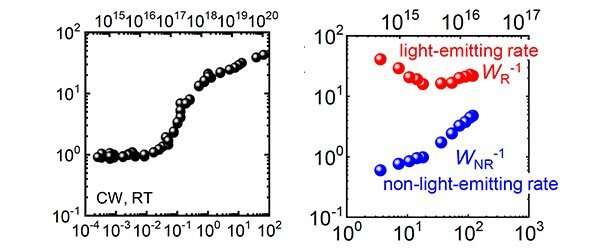The IQE curve obtained by the ODPL spectroscopy (left). The Y axis represents the IQE percentage, the lower X axis represents the excitation light power density Pcw (W cm-2) whilst the upper X axis represents the excitation rate G (sec-1 cm-2). The separated light-emitting rate (WR) and non-light-emitting rate (WNR) (right). The Y axis represents the inverse of rate (ns), the lower X axis represents the excitation light power density Ppulse (nJ/cm2) whilst the upper X axis represents the excited carrier concentration nini (cm-2). Credit: Tohoku University
Highly efficient electronic and optical devices are essential for reducing energy consumption and for the realization of an eco-friendly society.
ZnO is an attractive material among direct-bandgap semiconductors. They possess light-emitting properties as well as toughness to sustain large electric field that enables them to power electronic devices because of their large bandgap energy and large exciton binding energy. This also makes them suitable in radiation-resistant thin-film-transistors and heterostructure field-effect-transistors.
In high-quality ZnO crystals, nonradiative recombination centers (NRCs) are important for the near-band-edge (NBE) emission. These centers act as undesired energy dissipation channels and reduce the IQE of the NBE emission.
To understand whether the light-emitting process or the non-light-emitting process was more important in determining the behavior of IQE, Kojima and his colleagues measured the IQE values of ZnO crystal grown by the hydrothermal method. To do so, they employed a technique created by Kojima and fellow researchers known as omnidirectional photoluminescence (ODP) spectroscopy—a nondestructive method for probing semiconducting crystals with light to detect defects and impurities.
The IQE characteristics in ZnO crystals were examined under photo pumping conditions. IQE values indicated a constant behavior for weak photo pumping conditions and a monotonic increase for strong excitation. Because a significant decrease was observed for the non-light-emitting process with photo pumping, the origin of the IQE increase was revealed to be dominated by the deceleration of the non-light-emitting process due to the saturation of NRCs.
"Obtaining a quantitative breakdown of IQE from both processes allows us to better design semiconductors to improve IQE," said professor Kazunobu Kojima, lead author of the study.
More information: Kazunobu Kojima et al. Correlation between the internal quantum efficiency and photoluminescence lifetime of the near-band-edge emission in a ZnO single crystal grown by the hydrothermal method, Applied Physics Express (2020). DOI: 10.35848/1882-0786/abcd73
Provided by Tohoku University
























